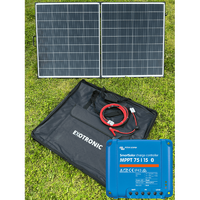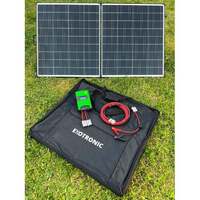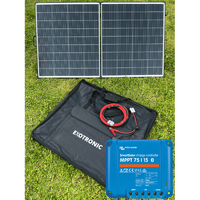Goal Zero Yeti 3000X Lithium Portable Power Station + Boulder 200 Briefcase Pack
SKU: 36410-32409 Learn More»








Product Description
Goal Zero Yeti 3000X Lithium Portable Power Pack and Roll Cart 276.1Ah + Boulder 200W Briefcase Solar Panels & Bag Pack, 2 Year Warranty.
Pack Includes:
Goal Zero Yeti 3000X Lithium Portable Power Station
Features:
- Increased 2000W AC inverter allows you to run just about anything you could from a wall outlet.
- Equipped with 60W USB-C Power Delivery ports for fast-charging phones, MacBooks, and other USB-C devices.
- 12V regulated port allows for greater compatibility with powering 12V devices such as portable fridges.
- Integrated MPPT provides up to 30% more efficient charge times when charging from solar.
- 2X faster wall charging with the introduction of our new faster Yeti Power Supply
The Goal Zero Yeti 3000X is an upgraded model of the old Yeti 3000 V2 Power Station. Now even better!
Goal Zero Boulder 200 Briefcase
Whether you’re boondocking, camping, or establishing home backup, these powerful 200-Watt tempered glass panels fold down to an easy-to-carry briefcase for the ultimate on-the-go setup.
Boulder 200 Briefcase Highlights:
- 200 total Watts - two 100-Watt panels (14-21.8V) chained together and connected by a hinge.
- Built with strong tempered glass and an aluminum frame with added corner protection.
- Included is a protective canvas bag for easy transport and carrying.
What Can The Boulder 200 Briefcase Solar Panel Charge?
The solar panel does not hold a charge - it produces power when it is exposed to sunlight. Connect it to recharge a portable power station. The Boulder 200 Briefcase is best used for recharging Goal Zero Yetis.
Product Charge Time From The Boulder 200 Briefcase:
| Product: | Charge Time: |
| Goal Zero Yeti 1000 | 10-20 Hours |
| Goal Zero Yeti 1250 | 12-24 Hours |
| Goal Zero Yeti 1400 | 14-28 Hours |
| Goal Zero Yeti 3000 | 30-60 Hours |
Specifications
SKU 36410-32409
Brand Goal Zero
Warranty Period: 2 Years
Product Category Solar Bundles
Solar Panel Type Folding Solar Panels
Solar Panel Cell Type Monocrystalline
Product Type Portable Power Station
Watt hours (Wh) 3032
Amp hours (Ah) @ V 280.8Ah @ 10.8V
NOTE 110V US Version shown in pictures. 240V AU Plug will be shipped. (Power Station)
Popular Product Applications Power Pack, lithium power pack, power station, camping battery pack, portable charger, camping solar panels, portable solar panels
Dimensions Open (LxWxH) 1400 x 44 x 1016mm (Solar Panel)
Included Solar panel includes integrated kickstands and handle and a protective bag for easy carrying.
Dimensions (LxWxH mm) 390 x 260 x 333mm (Power Station)
Dimensions Closed (LxWxH) 700 x 89 x 1016mm (Solar Panel)
Input 8 mm Charging Port: 14-22V, up to 10A (120W max) | Power Pole Charging Port: 14-50V, up to 50A (600 W max) (Power Station)
Operating Range (temp) 0-40°C (Power Station)
Suitable For Camping | 4WD
Videos
GOAL ZERO YETI 3000X | TECH VIDEO
EXPERIENCE THE POWER OF YETI X
Powering Your Trip With Caravan or Camping Solar Panels
Goal Zero: The Best Portable Power Packs for Camping?
The Best Camping Battery Packs
What Will My Camping Battery Run?
Goal Zero Boulder Solar Panels | Tech Video (Please note, US version may appear in video)
This is Goal Zero (Please note, US version may appear in video)
Goal Zero Yeti Powers: Camping Edition (Please note, US version may appear in video)
Goal Zero Yeti Powers: Home Edition (Please note, US version may appear in video)
How Solar Works (Please note, US version may appear in video)
Product Q&A
-
How long will the Yeti 3000X run my device?
All GOAL ZERO Power Banks and Portable Power Stations have a number in their name, ex. Guide10 Plus recharger, Goal Zero Yeti 1500X. These numbers refer to the Watt Hours (Wh), or the amount of energy that can be stored in each recharger, and how you’ll know if your gear is compatible with each recharger. For example, a 200Wh power station should run a 100W light for 2 hours (200/100=2). If your gear falls within the 1500Wh capacity of the Goal Zero Yeti, you’ll want to check the restrictions on each of the output ports.
Another factor in the math is how much power is being converted going from the Goal Zero Yeti battery to the device you are powering/charging. In some situations, like when running a 12V device, such as the LAL 350, directly off the 12V port, there will minimal conversion and thus very little additional losses. In using the USB ports to charge a phone, you add a layer of conversion (12V battery in the Goal Zero Yeti is being converted to a 5V USB output), which introduces around 10% of losses. When using the inverter, there are two layers of conversion (12V to high voltage, DC to AC). The least efficient way of using the battery in the Goal Zero Yeti is to use an AC-DC adapter off the AC ports, as is the case if you use a phone wall charger to charge your phone, as it adds yet another layer of conversion in the wall adapter.
So when you’re deciding on what to power from your new GOAL ZERO recharger, do some research into your device’s watt consumption. -
How do I know if my device will work with the Goal Zero Yeti?
First, you’ll need to determine the amount of power your device requires. This may require some research on your end, a good internet search or examining the user guide for your device should suffice.
Second, you will need to check the capacity for the individual output ports. For example, the Goal Zero Yeti’s AC port is powered by an inverter that allows for 300W of power. This means if your device is pulling more than 300W for an extended period of time, the Goal Zero Yeti’s inverter will shut off. Another number to watch for is the surge rating of your device as compared to that of the port. The Goal Zero Yeti inverter has an advanced surge management system that will maximize its compatibility with various devices, but there will still be items that will surge at a higher rate, and for a longer time, than the Goal Zero Yeti can manage, in which case the port will turn itself off.Finally, once you know your device is compatible, you’ll want to determine how long you’ll be able to power your gear from the Goal Zero Yeti. Here’s a quick and dirty lesson in power.
All Goal Zero power packs and solar generators have a number in their name, eg. Goal Zero Yeti 500X. These numbers refer to the Watt Hours (Wh), or the amount of energy that can be stored in each battery and how you’ll know if your gear is compatible with each Power Station. For example, a 200Wh Power Station should run a 100W light for 2 hours (200/100=2). If your gear falls within the 500Wh capacity of the Goal Zero Yeti, you’ll want to check the restrictions on each of the output
ports. -
What does the snowflake icon and the thermometer icon mean?
If your yeti displays the thermometer icon and a warning of HOT or COLD, this means you are either approaching or have exceeded the temperature thresholds of the Yeti. A warning of “cold” means you will need to warm the yeti in order to resume full functionality while “hot” means you need to cool the unit.
-
How do I know if my Goal Zero Yeti is charged?
To check the charge level of your Goal Zero Yeti, refer to the LCD Battery Display. When lit up, you’ll see a battery outline with 5 segments, indicating the current charge level. It is OK to use your Goal Zero Yeti even when it’s not fully charged.
-
Can I mount the Boulder Solar Panels to my roof?
Yes you can mount the Boulder Solar Panels to your roof. Goal Zero have designed the new Boulders to work with traditional z brackets so they’re easier to install. Pairing a Boulder Solar Panel and Goal Zero Yeti Portable Power Station for a camper or van? Talk about a match made in heaven.
-
Are the Boulder Solar Panels waterproof?
Yes. The Boulders are designed to withstand the elements, so they’re great for permanent installations. What you’re recharging from the Boulders is what needs your help to stay dry, so keep those power packs and power stations covered up and protected from the dust, rain, and snow.
-
Can I use my 3rd party panels with my Yeti?
Yes, you can, so long as you stay under 50V. If using multiple 3rd party panels, be careful! Chaining 3rd party panels together can be dangerous if done in the wrong way so visit Goal Zero's website www.goalzero.com/serissparallel to learn how to safely combine panels.
-
Why is the light on the AC button blinking on my Yeti 3000 Lithium?
A blinking light on the AC button indicates that at the current load, the AC inverter will be shutting off soon. Recharge your Goal Zero Yeti as soon as possible to continue powering your device. Once the AC inverter has shut off, the Yeti will attempt to reset itself three times. After three attempts, the AC inverter will remain off until you physically reset it by pushing the AC button or by recharging the battery a small amount.
-
What can I charge directly from the Boulder Solar Panels?
All of Goal Zero's Boulder Solar Panels are designed to charge Sherpa Power Packs and Goal Zero Yeti Portable Power Stations. If you’re looking to recharge things like headlamps, phones, and other USB devices, check out the Goal Zero foldable Nomad Solar Panels.
-
How do I know if my device will work with the Goal Zero Yeti 3000 Lithium?
First, you’ll need to determine the amount of power your device requires. This may require some research on your end, a good internet search or examining the user guide for your
device should suffice.Second, you will need to check the capacity for the individual output ports. For example, the Goal Zero Yeti’s AC port is powered by an inverter that allows for 1500W of power. This means if your device is pulling more than 1500W for an extended period of time, the Goal Zero Yeti’s inverter will shut off. Another number to watch for is the surge rating of your device as compared to that of the port. The Goal Zero Yeti inverter has an advanced surge management system that will maximize its compatibility with various devices, but there will still be items that will surge at a higher rate, and for a longer time, than the Goal Zero Yeti can manage, in which case the port will turn itself off.
Finally, once you know your device is compatible, you’ll want to determine how long you’ll be able to power your gear from the Goal Zero Yeti. Here’s a quick and dirty lesson in power. All Goal zero power packs and solar generators have a number in their name, ex. Guide10 Plus Power Pack, Goal Zero Yeti 3000. These numbers refer to the Watt Hours (Wh), or the amount of energy that can be stored in each recharger, and how you’ll know if your gear is compatible with each recharger. For example, a 200Wh recharger should run a 100W light for 2 hours (200/100=2). If your gear falls within the 3000Wh capacity of the Goal Zero Yeti, you’ll want to check the restrictions on each of the output ports.
Another factor in the math is how much power is being converted going from the Goal Zero Yeti battery to the device you are powering/charging. In some situations, like when running a 12V device, such as the LAL 350, directly off the 12V port, there will be no conversion and so no additional losses. In using the USB ports to charge a phone, you add a layer of conversion (12V battery in the Goal Zero Yeti is being converted to a 5V USB output), which introduces around 10% of losses. When using the inverter, there are two layers of conversion (12V to high voltage, DC to AC). The least efficient way of using the battery in the Goal Zero Yeti is to use an AC-DC adapter off the AC ports, as is the case if you use a phone wall charger to charge your phone, as it adds yet another layer of conversion in the wall adapter.
So when you’re deciding on what to power from your new GOAL ZERO recharger, do some research into your device’s watt consumption.
-
Does the Goal Zero Yeti 1400 / 3000 Lithium Power Pack have wifi capabilities?
Hi there,
No the Goal Zero Yeti 1400 / 3000 Lithium Power Pack do not have wifi capabilities. The international models do have the wifi functionality, however this feature is not provided with Australian models.
-
How long will it take to charge my Goal Zero Yeti from a Boulder Solar Panel?
That depends on a few factors – how big the Yeti is, how big the Boulder is, how cloudy it is, how hot it is, just to name a few. Goal Zero have created a handy calculator that takes all of these factors into consideration. Also, great news, all the Yetis allow for something called “pass-through power”, this means you can be trickle charging your Yeti and using it to power your gear, all at the same time.
-
What's the difference between Mono & Polycrystalline solar cells?
There's actually not a whole lot of difference when it comes to Caravan, RV and Camping applications to be honest. They are different cell types and are more relevant for home grid tied roof top.
You will read that poly are better in low light conditions and mono are more efficient. But for roof top caravan's the difference is negligible.
The most important thing is to get a well-constructed roof top panel from a quality brand and get the right sizing for your application.
-
Can I chain multiple goal Zero panels into a Yeti X?
Yes, Goal Zero's panels are designed to be safely chained together out of the box and eliminate the risks associated with 3rd party panels.
-
Can I replace the battery in my Goal Zero Yeti 1000 / 1400 / 3000 Lithium?
Yes, the battery inside the Goal Zero Yeti 1000 / 1400 / 3000 Lithium is designed to be easy to replace.
1. Turn your Goal Zero Yeti upside-down and place its top surface on towel or blanket over a hard surface.
2. Remove the 10 screws on the bottom plate.
3. Unscrew the 2 bolts that connect to the battery terminals.
4. Pull on and disconnect the data connector to the battery.
5. Remove the 8 screws holding the battery pack to the Goal Zero Yeti.
6. Lift the old battery out of the body of the Goal Zero Yeti **This battery is HEAVY. Use caution and proper technique when lifting.
7. Insert replacement battery and reassemble in reverse order of steps above.
8. Replaceable batteries will be available from GoalZero.com. -
Can I chain a Boulder 200 Briefcase with other Boulders?
Yes, the Boulder 200 Briefcase can be chained with other Boulder Solar Panels, including multiple Boulder 200 Briefcases, by using an APP combiner cable.
-
What type of battery is in my Goal Zero Lithium Yeti 400 / 1000 / 1400 / 3000?
Your Goal Zero Yeti Lithium uses custom designed Lithium Ion. Here are some basic facts about Lithium Ion batteries:
1. Lithium Ion batteries can store and release a lot of energy in a short period of time. The batteries in your Goal Zero Yeti are in a protective enclosure with a sophisticated battery management and protection system controlling its terminals to the outside world.
2. It is critical that your battery does not get wet as moisture and water can get into the battery cells behind the protection circuitry and bypass that protection.
Customer Reviews
Warranty
For details relating to this product's warranty CLICK HERE
Delivery
For details relating to our delivery process CLICK HERE





















